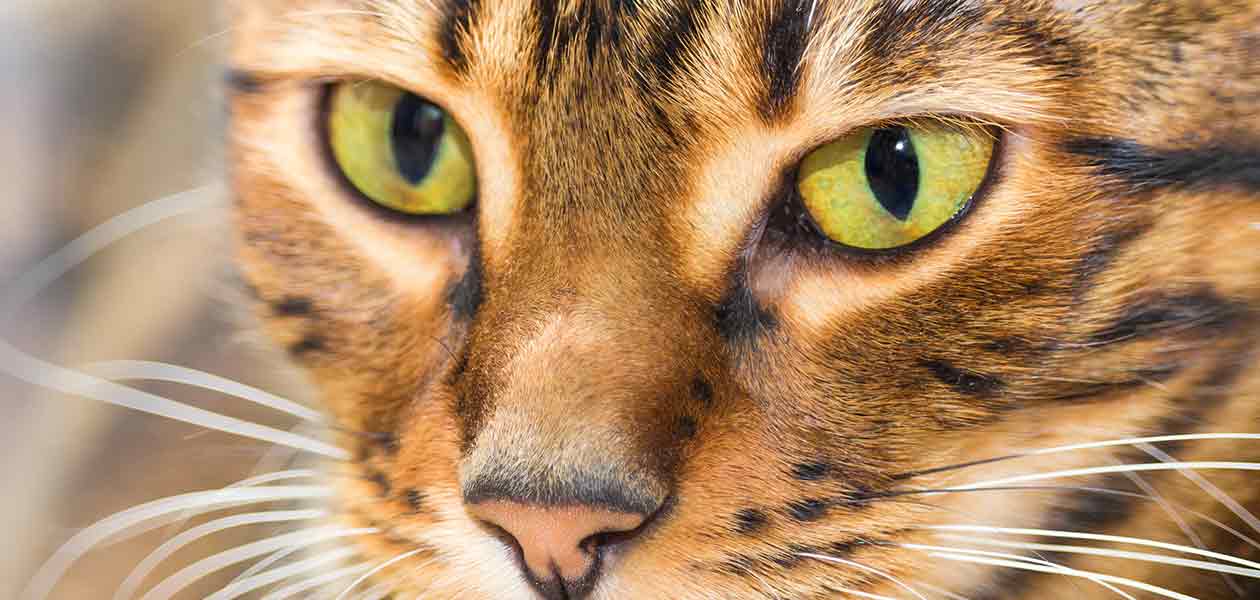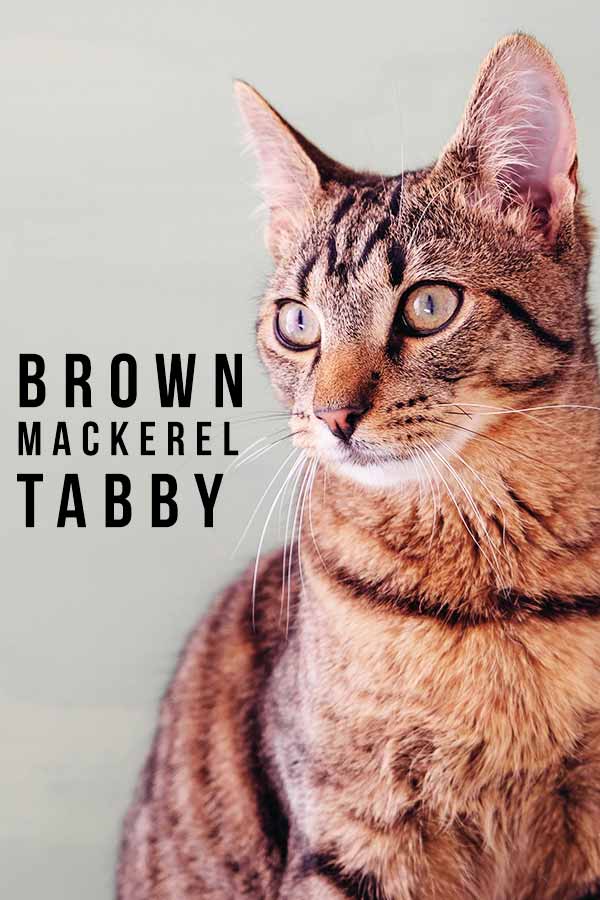
Brown mackerel tabbies have black patterns over a warm, brown or bronze base color. The mackerel pattern has narrow stripes that look similar to the bones of a fish – hence the name of the pattern.
Your tabby’s pattern won’t affect his health or temperament, so all tabbies have similar temperaments.
Let’s take a closer look at how this pattern happens and what to expect from a brown mackerel tabby.
Quick Links
- What is a tabby cat?
- What is a mackerel tabby?
- Mackerel tabby colors
- Genetics of the brown mackerel tabby
- Tabby history
- Brown mackerel tabby temperament
- Brown mackerel tabby health
Let’s start by taking a look at what a tabby cat is.
What is a Tabby Cat?
The term ‘tabby’ actually describes the coat pattern on your cat. It doesn’t refer to a single breed. Loads of different breeds, and mixed breeds, can have the tabby coat pattern.
In fact, the tabby pattern is the most common pattern seen on domestic cats around the world.
The striped tabby pattern helps cats to camouflage in the wild, so they can catch their prey more easily and hide from predators.
Within the tabby pattern, there are three types of markings. These are:
- Spotted
- Ticked
- Mackerel
The last of these is the pattern we will focus on in this guide.
What is a Mackerel Tabby?
So, ‘mackerel’ is just one type of tabby pattern that cats can have. But what sets it apart from the other types?
The mackerel tabby pattern is the most common type of tabby pattern.
Mackerel pattern tabbies have narrow stripes, reminiscent of a fish skeleton because they run parallel to one another.
Just like all other types of tabby, the mackerel tabby will have a distinctive ‘M’ shaped marking on its forehead.
It will also have black outlines around its nose and eyes.
Patched mackerel tabbies can have that mackerel pattern, but also patches of other color.
Mackerel Tabby Colors
We’re focusing on the brown mackerel tabby today. And, this is the most common color for cats with this pattern.
Brown mackerel tabbies will have black markings over a warm brown or bronze base color.
But mackerel tabbies can also come in the following colors:
So, how does the brown mackerel tabby pattern come about? Let’s dive into tabby genetics.
Brown Mackerel Tabby Genetics
Cat color genetics can be quite complicated. So, today we will only touch on those that create the tabby pattern and brown color.
Cat colors are created through two pigments: eumelanin (black) and pheomelanin (red). Eumelanin is the one we need to focus on.
Although the default color of this pigment is black, it can be turned into brown if your cat inherits the recessive ‘b’ gene from both parents.
But, this is just how the brown color happens. So how do our cats get that beautiful tabby pattern?
Tabby Pattern Genetics
Tabby patterns get determined by genes at the T locus.
‘Locus’ is the words to describe a place on the genetic code where the genes for a particular characteristic are located.
Mackerel stripes are determined by the Tm gene at the T locus.
Classic tabby blotching is caused by the Tb gene, and ticking is caused by Ta.
The mackerel pattern is dominant over the blotched pattern, which is why it is more common.
But, ticking is dominant over mackerel stripes.
Inheriting the Mackerel Pattern
Your cat receives one tabby gene from each parent. So let’s take a look at which combinations could result in this pattern.
- TmTm – Mackerel pattern
- TmTb – Mackerel pattern
- TmTa – Ticking pattern
So, as long as your cat inherits either two Tm genes, or one Tm and one Tb, you will have a mackerel tabby.
The ticking gene overrides both other patterns, but since it is also quite contained within a small number of breeds (notably the Abyssinian), it doesn’t stop there being a lot of mackerel tabbies!
Brown Mackerel Tabby History
Now that we’ve learned a little more about how the beautiful mackerel pattern happens, let’s take a closer look at the history of this interesting coat.
As we mentioned earlier, tabby just refers to a pattern. So, its history is widespread across a variety of cat breeds.
If you’re interested in learning more about the history of a specific cat breed you can take a look at our complete cat guides for more information.
However, the mackerel pattern is often considered to be the original tabby coat pattern.
There is a lot of myth and theory about where the word ‘tabby’ came from, as well as what the ‘M’ on a tabby’s forehead means.
But you can read more about these historical debates here.
Brown Mackerel Tabby Temperament
If you’re considering bringing a brown mackerel tabby into your home, you’ll want to learn a little more about their temperament.
Generally, tabbies are known for being sweet, outgoing, and social. They’re great cats to bring into the family if you have children.
Remember to look at specific breeds for more information.
Brown Mackerel Tabby Health
Many people wonder whether a cat’s coat color and pattern will have an impact on its health.
However, you don’t need to worry about this with the brown mackerel tabby.
Although deafness has been linked to white color coats in cats, the brown mackerel pattern has not been linked to an increased risk in health conditions.
The best way to get a healthy cat is to choose a reputable breeder.
Brown Mackerel Tabby – Summary
Brown mackerel tabbies are the most common type of tabby coat pattern.
They have a reputation for being a great ‘first cat’. Of course, to find out more about the personality and health of various breeds, you should take a closer look at the breed as a whole.
If you have a mackerel brown tabby, we would love to hear more about your kitty. Tell us what they’re like in the comments!
References and Resources
- Jacobberger, P. ‘Coats and Colors: How Does the Description Work?’, The Cat Fanciers’ Association (Accessed April 2020)
- Hartwell, S. ‘Colour and Pattern Charts’ (Accessed April 2020)
- Griffin, B. ‘Cat Identification’, University of Florida College of Veterinary Medicine
- Kaelin, C. & Barsh, G. ‘Tabby Pattern Genetics – A Whole New Breed of Cat’, Pigment Cell & Melanoma Research (2010)
- Kaelin, C. & Barsh, G. ‘Genetics of Pigmentation in Dogs and Cats’, Annual Review of Animal Biosciences (2013)
- Lyons, L. (et al), ‘The Tabby Cat Locus Maps to Feline Chromosome B1’, Animal Genetics (2006)
- Eizirik, E. (et al), ‘Defining and Mapping Mammalian Coat Pattern Genes: Multiple Genomic Regions Implicated in Domestic Cat Stripes and Spots’, Genetics (2010)

Mine was so tiny now just shy of 6months old he is practically full grown. He loves to run and jump he will lay on me however no one not even myself can pet/cuddle him he will bite hard. But he will snuggle on me. I can’t see a way to post a pic
We got Cookie & her sister Hoss as 16 week old semi-feral siblings who were used to having food put out by humans but had never been handled. Hoss is all black; Cookie is a mackerel tabby with black markings over a golden tan base that is ticked with silver on the ends. Her fluffy abdomen fur is tan. Her fur is super short and silky like a pelt , she has no white except a tiny bit under her chin, , the backs of her feet are black, and she has very definite stripes thst break unto spots across her flank. She is the most adventurous playful cat I have ever had. After 4 months with us she began to head bump and purr at me and now after 8 months- one year old -she loves to be patted. They both sleep on the bed now but black cat Hoss still doesn’t like to be touched.(I think she loves me though-her love language is just different- she stares and blinks at me from a safe distance 💕)
My 6 month old Gracie May, I’m told, is a Brown Mackerel! Until just now after doing a search on your site did I know there was such a type of kitty! My Wendy was one too! Gracie is a VERY cuddly kitty! She rubs all over my face in a spazy manner & often leaves my face wet..lol She loves to sit on my lap & on my bed at night & also has an abundance of energy & loves to chase the “Red Bug” a laser light & a fish on a pole! I found I wasn’t feeding her quite enough & she started biting! I never play with her with my hands so knew there was a reason! I’ve increased my play with her as she will bite trying to play too! Thank you for your info! I always wondered why Tabby’s have the M! Blessings! 😃
Love the name Gracie May 🙂